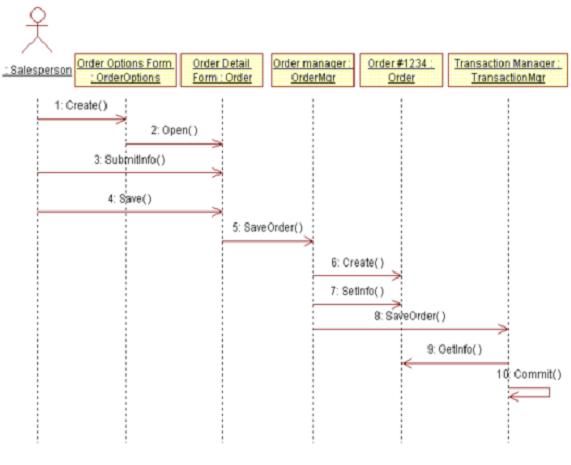A brief summary of UML & Rational Rose – Interaction Diagrams, Part III
5. Interaction Diagrams
Interaction Diagrams consist of Sequence diagrams & Collaboration diagrams.
- Interaction diagrams are models that describe how groups of objects collaborate in some behavior.
- Typically, an interaction diagram captures the behavior of a single use case. The diagram shows a number of example objects and the messages that are passed between these objects within the use case.
5.1 Sequence Diagrams
Sequence Diagrams have the following specialties.
- Order by time
- Read the diagram from the top to the bottom
- Represent one of the flows through a use case
- Sequence diagrams must reside directly within a use case or directly within a package.

5.2 Collaboration Diagrams
Collaboration diagrams focus more on the relationships between the objects.
Collaboration diagrams are usually created in the browser, directly underneath a use case or a package.

TIP of creating a collaboration diagram in Rational Rose: Browse/Create Collaboration Diagram F5
Collaboration diagrams mainly contain the following elements.
Actor - Drag the actor from the browser to the open diagram.
Object - Mapping an Object to a Class.
Message - Communication between objects in which one object ask another object to do something.
5.3 Using Object Persistence in Interaction Diagrams
Persistence defines the lifetime of the instances of a class. A persistent element is expected to have a life span beyond that of the program or one that is shared with other threads of control or other processes. Use this field to identify the persistence for elements of this class:
Persistent - A persistent object is one that will be saved to a database or some other form of persistent storage. The implication here is that the object will continue to exist, even the program has terminated.
Static - A static object is one that stays in memory until the program is terminated. It lives beyond the execution of this Sequence diagram, but is not saved to persistent storage.
Transient - A transient object is one that stays in memory only for a short time.